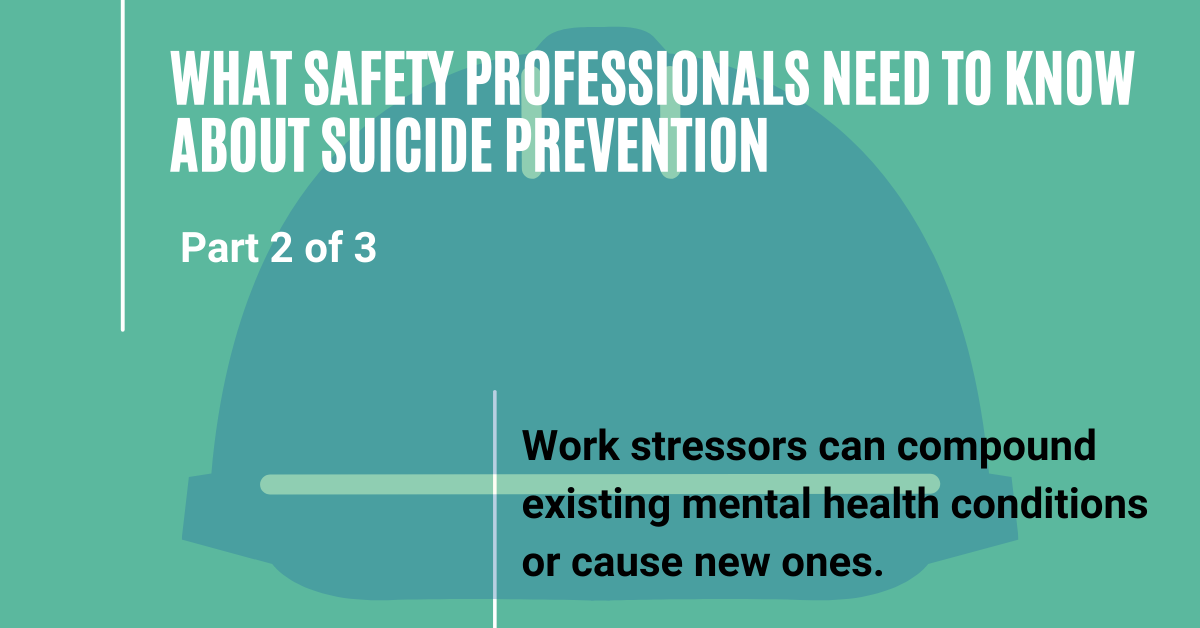Identifying and Assisting Workers Who May Be At Risk

Last week, I wrote about how to create a psychologically safe environment to support good mental health in the workplace. I discussed how improving listening skills and noticing body language cues are helpful in identifying a worker who may be at risk. Also discussed are ways to verbally offer support.
Today, I will expand on information to help identify and assist workers who may be at risk.
Recognizing Risk Factors
There’s no single cause for suicide or attempted suicide. It is typically a combination of a lot of stressors and feeling hopeless to solve them. However, depression is the most common condition associated with suicide.
Risk factors vary, and research has uncovered all of the following:
- mental illness
- alcohol and substance abuse disorders
- a major physical illness
- negative life events such as divorce
- family history of suicide
- previous attempts
- being a victim of abuse
- access to firearms or other weapons
- access to lethal medications
While it’s important to be aware of these risk factors, it is equally important to know how to respond to and assist workers who display these risk factors.
Assisting Workers Who May Be At Risk
It’s not easy to collect the information you need from a worker to decide if intervening is necessary but time is of the essence when someone is struggling with suicidal ideation. Workers are protected from answering questions by the ADA and HIPAA. So, first, it’s important to work in conjunction with HR or the company’s legal department in determining approaches to difficult conversations any time you suspect risk factors are present.
Research indicates that the pain of perceived exclusion from social communities seems to be a strong contributor to deaths by suicide. One theory (the interpersonal theory of suicide) discusses this in detail. While some view workplaces as positive extended social communities, others can feel very excluded. We spend a great deal of time at work, so a question we need to be asking ourselves is “how inclusive is my workplace?”
Next, creating a resource document may help tremendously. Depressed people who feel hopeless do not have the energy or even the will to look for resources.
The most commonly reported reasons workers don’t get help are:
- lack of insurance coverage.
- difficulty understanding covered services.
- not knowing which resources are available.
- difficulty finding providers.
- long wait times to get in to see them.
The resource document could address and assist with some of the challenges above. Include details about:
- the company’s EAP.
- local mental health professionals covered by the worker’s health plan.
- local treatment centers.
- free support groups.
- the suicide hotline number and internet chat link.
Listen empathetically but don’t cross a boundary and we try to give advice or mental health counseling. No matter how well-intentioned that could go terribly wrong for both you and the worker. Having a resource available to discuss, and letting them know they are supported by the workplace might help them get started on a better path. Audit what’s in place at your workplace now and think about expanding mental health benefits and policies. Or, consider creating company programs.
Finally, making mental health a priority in the workplace will help workers feel more comfortable about disclosing any issues they are having. This may include expanding benefits as mentioned above. It may also include training workers about suicide prevention, how to recognize signs of depression, and how to support one another through the crisis.
Most people who actively manage their mental health conditions go on to engage in full lives. There is hope! And all of us can make a difference in someone’s life. I hope this post has been helpful in identifying and helping workers who may be at risk. Check back next Friday for the final installment in this series, “Investigating and Responding to a Possible Suicide at a Worksite.”



